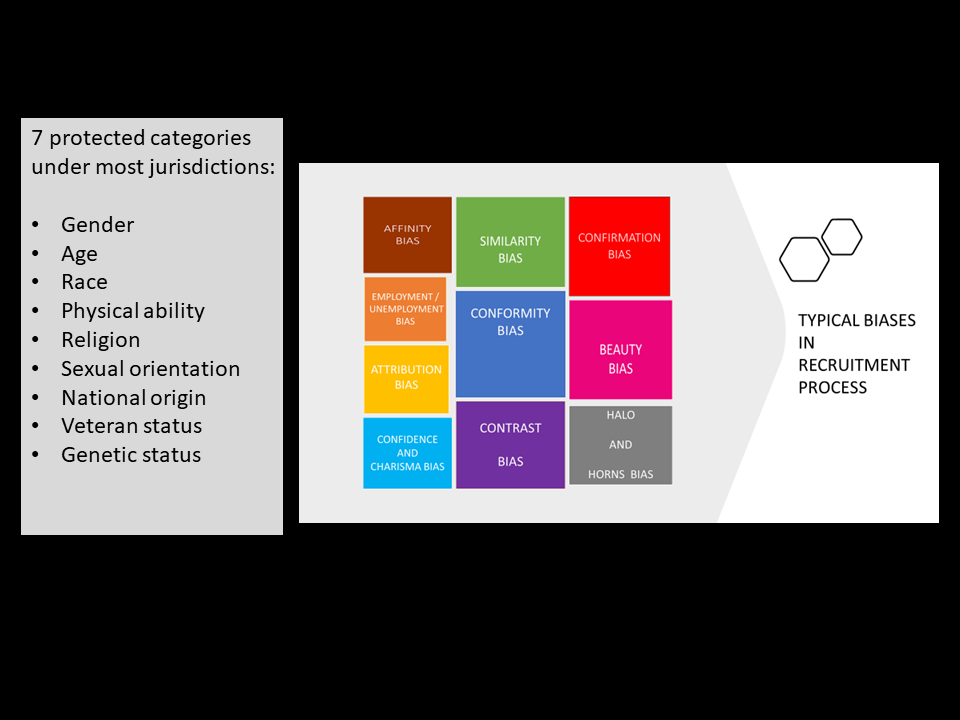The hiring process for most organisations is flawed throughout and riddled with unconscious bias. Despite good intentions, there is no doubt that unconscious bias is the barrier to diversity. It’s important you understand how to make your interview process more inclusive as part of your hiring best practices.
Inclusive hiring
Inclusive hiring is an equitable and consistent process, which is as bias free as possible. This will allow the selection of the best candidate, who has been chosen for the right reasons related to skills, qualification, and experience, not the frequently unconscious whim of the recruiter or hiring manager.
The importance of inclusion
Research tells us that Millennials are looking for organisations which are diverse and inclusive. In a survey carried out by Monster, 87% say it’s a factor in their hiring decision. They are also willing to leave a business that turns out not to be walking the talk. The FT published a report on the most inclusive companies in Europe based on feedback from employees, which is important. However, even though there is a commitment to a general Diversity, Inclusion and Belonging policy at a senior level, very often we see pockets of resistance at a local or departmental level.
Candidates can have indirect contact with organisations as consumers or via social media or advertising, but the hiring process is frequently the first direct contact. It’s important that this experience is as inclusive as possible. It’s vital that you integrate diversity and inclusion values into every aspect of the hiring process, but especially the interview section.
7 protected categories
At one time I assumed that anyone involved in the hiring process was aware of the seven protected categories. That was an error of judgement on my part. You would be surprised how many are not aware that it is illegal to discriminate candidates on the following grounds in most geographies. Anyone who discriminate against individuals in these categories risks legal action.
- Gender
- Age
- Race
- Physical ability
- Religion
- Sexual orientation
- National origin
- Veteran status
- Genetic status
How to make your interview process more inclusive
- Write inclusive job profiles and adverts
It’s important to correctly format your basic documentation because they are the tools which will anchor the entire hiring procedure. If your recruitment foundation is not accurate, it will throw out all the subsequent steps. There are many software programmes on the market that can help recruiters design inclusive documentation. Even MS Word has an inclusion piece in the editing function.
Vocabulary choice is key to making the advert accessible and to prevent self-deselection. Research shows that women are put off my certain word usage, especially if they feel they don’t meet the qualifications. It’s important to keep skills and competences real.
A Hewlett Packard internal report found that men apply for a job or promotion when they meet only 60% of the qualifications, but women apply only if they meet 100% of them. In-house recruiters report encountering significant difficulties at this stage when hiring managers want to inflate profiles and recruit “Mini-Mes”
- Give unconscious bias training to all involved
All organisations should offer unconscious bias training to everyone involved in the hiring system. Even the hiring manager. In fact, especially the hiring manager. I have been in touch with large numbers of in-house recruiters who say that very often the point of greatest resistance to an inclusive hiring decision, is the hiring manager.
Don’t forget this is a topic that needs ongoing refreshing. It’s not something that can be dealt with in a one-off lunch and learn session, because behavioural change is a continuous not a single event.
There are about 150 cognitive biases in all and many of them crop up in the interview. Typical biases found in the hiring system are affinity bias, confirmation bias, halo and horns bias, similarity bias, contrast bias, beauty bias, conformity bias, affect heuristics bias, unemployment bias, expectation, and confidence bias.
In the era of the online interview, we are also seeing “background bias” where candidates are judged on their surroundings. I hear of candidates who rent hotel rooms to get a more professional looking environment if they can’t set up a virtual background.
None of us can never be completely bias free, but you can learn to manage them and set up systems to support you.
- Have a diverse interview panel
Your interview panel should involve a range of personalities, backgrounds, ages, and experience. Avoid a mono-cultural group, as this will end up in “group think”.
Remember the Benjamin Franklin quote “When we all think alike – no one is thinking.”
- Design a structured interview
Interviewers should pose the same questions to all candidates and only those directly relevant to the role. Check you ask open-ended and future-focused behavioural questions to produce the best results.
A standard questioning route would be to ask questions based on previous experience such as “Tell us about a time you….”
Instead reframe that around and make it about something that could happen. “How would you ..?.”
One of the reasons for doing this is that research shows that women tend to under-value their own competence and performance (Imposter Syndrome) but feel comfortable sharing how they would deal with a projected future scenario. What deters women is not their ability, but their perceptions of their skills and experience.
You can also set practical skills-based screening tests or exercises.
- Build in bias interrupters
A good best practice to conduct an inclusive interview is to have bias interrupters. Allocate roles for people involved in the hiring process to spot and interrupt bias. You can train a team and equip them with skills specifically to identify and communicate bias.
Develop a consistent benchmarking scale to measure candidate answers (or skills-based assessments) to generate data to develop selection guidelines. Include all candidates, especially those who you consider to be “outliers” or even “non-starters”
If you decide that “cultural fit” for the team or organisation is a selection criterion, measure it in precise terms to avoid a homogenous hire. This will be important around personality types, gender, race, age etc. Cultural fit is shorthand for “like us”.
Pay particular attention to personality assessment. The interview process tends to favour extraverts (confidence and charisma bias) and in our cultures we tend to place higher value on extraversion than introversion. The best way to do that is via personality testing of the whole team to gain an understanding of where you need balance.
Many interviewers also give weight to non-competence-based elements such as a sense of humour, the receipt of thank you letters, sports played or personal interests. This can be excluding in terms of gender, age or culture and tapping into confirmation bias or similarity bias. If the hiring manager shares the same interests, personality, sense of humour or comes from a culture where thank you letters are expected then there is a risk they will be persuaded to show preference for those candidates.
- Avoid tokenism
Make sure to balance your short list in terms of gender, age, personality types, ethnic background etc. There is strong evidence to suggest that the single candidate from a particular demographic will not get hired.
This was identified by research carried out by University of Colorado’s Leeds School of Business on female and black applicants. Their findings indicated that panellists favour the dominant group in preference to “outside” candidates from other demographics.
Get feedback
If your organisation truly intends to gain an understanding of candidate experience with the intention of improving it, send out a post-interview pulse for feedback. Results will indicate how candidates felt about their experience of your interview process and if they felt it was inclusive.
An inclusive hiring process will give all candidates the opportunity to be their best authentic selves and just as importantly your organisation will have a chance to show what a great place it is to work.
Need help transforming your hiring process to be more inclusive – get in touch now!






